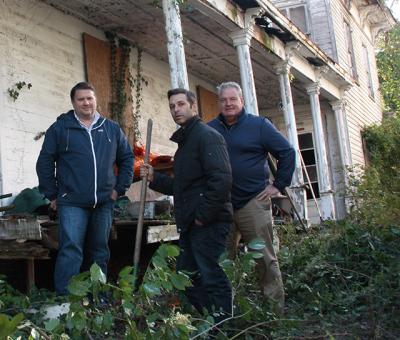Kids Try to Make Sense of Election
Kids Try to Make Sense of Election

Maximillian Osborn said he signed up for East Hampton High School’s Advanced Placement government class to help him figure out whom to vote for in this year’s presidential election, but two months into the class, even with daily discussions of the race led by his teacher, Billy Barbour, Maximillian, 18, still has no idea who he will vote for on Tuesday.
“I personally am really annoyed that this is my first election and these are my options right now,” he said to a reporter visiting his class on Monday. “I’m not a fan of either candidate right now. . . . Their morals just don’t seem in line for a president, I think.”
Feverish discourse on the 2016 election is seemingly everywhere right now — from newspapers and television to social media and even in the hallways and classrooms in our schools. The students are being inundated with information and opinions, Mr. Barbour said. “They are a lot more informed than in previous generations. . . . They have access to all the technology. When I was a kid, there were three channels. If I didn’t want to hear Ronald Reagan, I would turn off the TV or switch channels. That’s not an option for them. They’re in it to a degree I don’t think I’ve seen before.”
One of his students, Ciara Bowen, confirmed his theory. “You can’t avoid it,” she said. “You have commercials on your Snapchat, and it’s always on Facebook. Everyone is forced to be part of this election, more so than elections in the past. It’s because of how big of a character these candidates are. They’re kind of wild.”
The Ross School held a teach-in yesterday, bringing together students and teachers from 7th through 12th grades — for a whole day of lessons on government, history, politics, and issues such as foreign policy, immigration, health care, and the Supreme Court. Kevin Snyder, a cultural history teacher there, called this year’s election “a teachable moment.”
“To talk about what has been said has been challenging,” he said. “This isn’t a normal election. I think everyone can agree with that. It has been difficult to look at some of the things that have come up and discuss them with students.”
He has observed Ross students to be “keenly interested in the election,” particularly those who are headed into college next year or who are international students living in this country.
“We are focusing on the present but turning toward the future,” Mr. Snyder said.
For some students, the election is a real-time history lesson, but others are frustrated that the process seems to have devolved into something else. “I think it’s not even about politics anymore. I feel like this election is just getting so far off topic,” said Jacqui Thorsen, an East Hampton senior.
At Pierson High School, students in the International Baccalaureate first-year history course went all in on the election last week, teaming up as Republicans or Democrats to hold a mock debate moderated by two peers and their teacher, Ruth White-Dunne. It was so intense that some of the students admitted afterward they had been dreading the exercise.
“The debate itself was very stressful to prepare for, but I think it was very important to talk about politics because it does affect our everyday lives,” said Alex Dudley, a junior. “Our parents and the news tell us what to think, and us developing our own opinions is what I think is the most important.”
A classmate, Hope Brindle, agreed. “There is a horrible sense of dread when you’re about to share what you believe in with people you know who don’t share the exact same thing,” she said. “Not because you don’t respect their beliefs . . . but because there will be some conflict between the parties. But it’s important to talk about those kinds of things with people who have different opinions than you in a nontoxic environment, and I’m glad I got that opportunity.”
Hillary Clinton and Donald Trump have even had a presence in elementary classrooms, though it is more subtle. Mark Carlson, who teaches second and third grades at the Wainscott School, said that his students know the two candidates’ names and what they look like, but may not know what they stand for. “They’re definitely aware of them, which I think speaks volumes, whether positive or negative,” Mr. Carlson said.
As Election Day approaches, Mr. Carlson has been leading lessons on how the U.S. government works. The activities will culminate in a mock election on Monday, but instead of casting a ballot for Mrs. Clinton or Mr. Trump, the Wainscott children will vote for a fictitious class president — “Billy,” “Sarah,” or “Brian,” who are proposing ideas such as more recess or less recess, no homework, fewer tests, and free candy at school.
“It’s a little difficult to get politics involved in schools with the younger kids,” Mr. Carlson said. “They start bringing in things that adults share with one another, and I don’t know if I wanted the culture of the classroom to reflect that. It has been pretty crazy.”
Older students seemed frustrated by the election, especially those old enough to understand the national discussion but not old enough to vote. And many are anxious about the results.
“I am stressed, definitely,” said Nia Dawson, a 17-year-old Bridgehampton senior in the school’s A.P. government class. “I’m going to be 18, 19, 20, and this person will be in office during some of the most important years in my life.”
“It is our future representative and leader of the U.S. that is on the line here,” Thomas Brooks, a Pierson junior, said. “Although we are not making an impact on that, I think there’s always stress involved because it’s such a big role to be filled.”
“People often don’t realize how much this election is actually going to affect us, because over the next four years we’re going to be done with high school and some of us are going to go straight to having a job,” said Gregory Baum, another Pierson junior. “The person who is elected is really going to affect what it’s going to be like finding a job.”
Raymond Maldonado, another Bridgehampton senior, fears electing a president who is eager to go to war, because of the prospect of the military draft. Raymond, 17, lost a cousin last year to the conflict in Iraq. “I’m going to be 18, but I didn’t have a vote. It’s going to affect my life directly even though I had no say in it.”
What also became clear is the role schools play in teaching children about politics, civics, and government. Many students and teachers interviewed agreed that it is imperative that schools teach or talk about the election. Raymond, who transferred to Bridgehampton two weeks ago from a school UpIsland, said no one was talking about the election at his old school.
“We expect our schools to teach our kids physics, math, and all of that, but if we’re not expecting them to teach about politics, who is going to teach them?” he said. “I was definitely looking at both sides before I came here. . . . How are you supposed to know if you’re not educated?”
The 2016 election has helped Alexandra Perez, an East Hampton senior, learn how important it is to be engaged in politics.
“People do have the ability to change things,” she said, “if they’re voting even in minor elections for local boards. You don’t have to be hardcore out there in every campaign, but it’s definitely important to be informed and do your part.”






